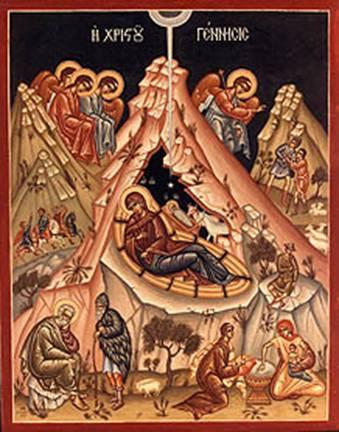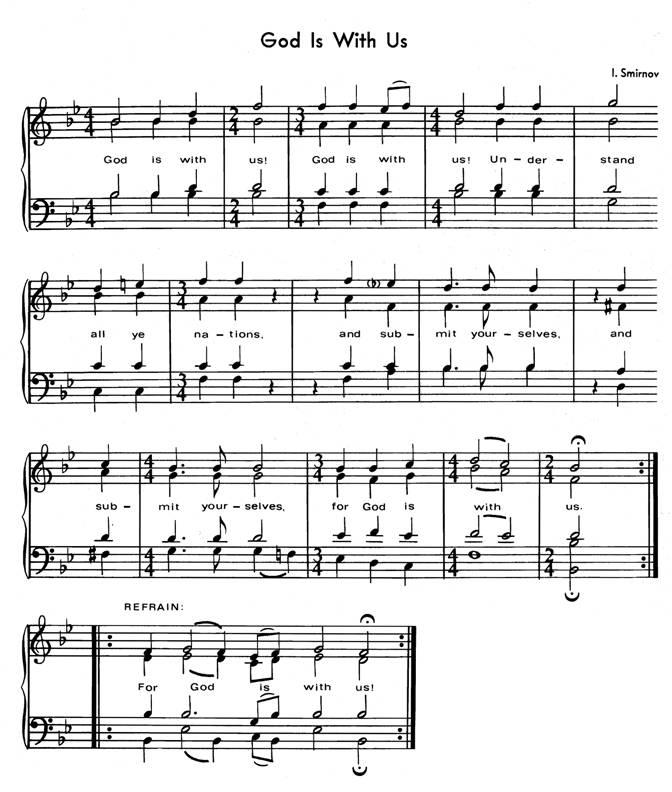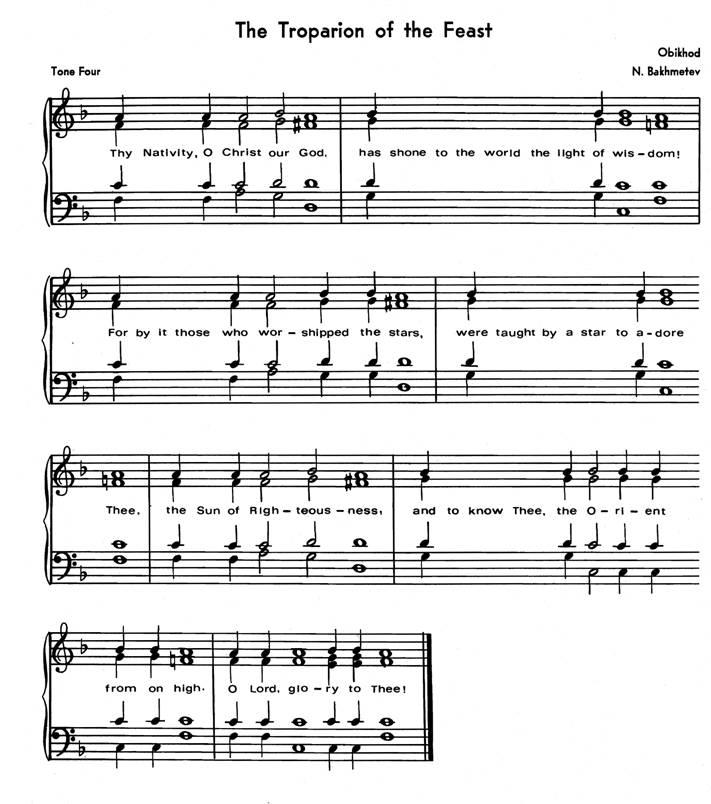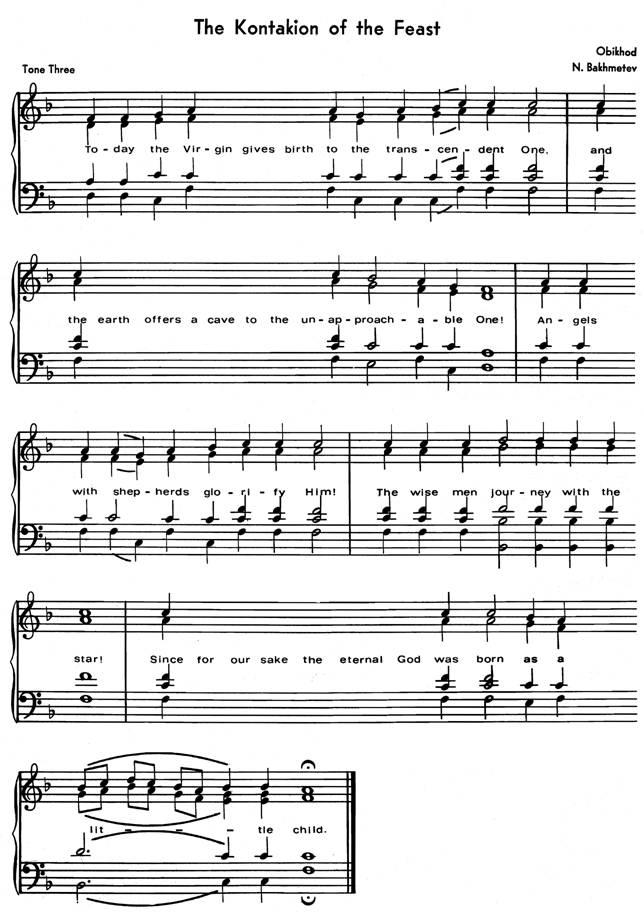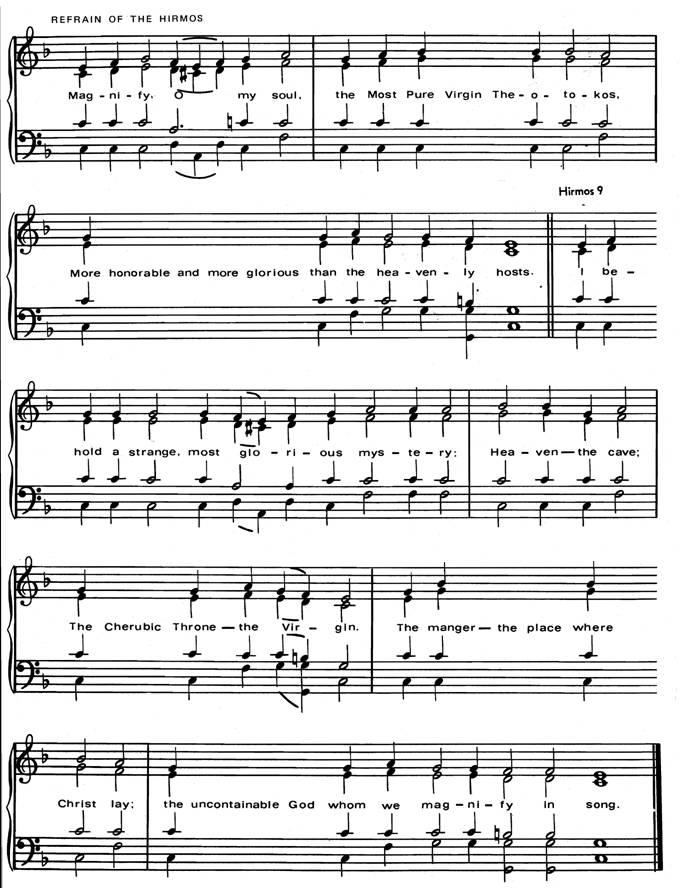Nativity
THE NATIVITY OF OUR LORD JESUS CHRIST
Objectives:
- Students should be able to identify the characters in the icon and tell the story.
- Students should know the date of the feast (December 25).
- Students should be able to recite or sing the Troparion and the Kontakion.
- Students should know the Christmas greeting: Christ is born! Glorify Him!
Possible Lesson Plan:
- Open with prayer.
- The icon: Ask how much the students already know about the story of the feast. Who are the characters in the icon? The Theotokos and Child, St. Joseph (being tempted by Satan to doubt the virgin birth), Satan (in dark colors, the Prince of Darkness), a shepherd (facing the angels as they tell of His birth), the Magi (What is their symbolism? 1 beardless and young, one middle-aged, and one old, representing all mankind), the Angels, the cow, and the star. Note: not all icons have the Magi. Is it day or night in the icon?
- Scripture readings:
Gospel: St. Matthew 2:1-12. Read also Luke 2:1-20 from Vespers.
Epistle: Galatians 4:4-7
Old Testament prophecies: Psalm 109: 1-4, Micah 4:6-7, 5:2-4, Genesis 14:17-20, Isaiah 8:9-18, 9:1-6, 7:14, 60: 5-6, Numbers 24-15-17, Malachi 3:20. Listen to the songs of the feast for these references.
- Songs of the Feast:
Troparion: Thy Nativity, O Christ our God, hath shown to the world the light of wisdom. For by it those who worshipped the stars were taught by a star to adore thee, the Sun of Righteousness, and to know thee, the Orient from on high. O Lord, glory to thee!
Kontakion: Today the Virgin gives birth to the Transcendent One, and the earth offers a cave to the Unapproachable One! Angels, with shepherds, glorify him! The wise men journey with the star! Since for our sake the eternal God was born as a little child!
Canon: I behold a strange and wonderful mystery: the cave a heaven, the Virgin a cherubic throne, and the manger a noble place in which hath lain Christ the uncontainable God. Let us, therefore, praise and magnify Him.
- Discussion questions:
What is Advent? How long is it? How do we observe it? Where was Jesus born? Why there? How did God arrange for the prophecy of Micah to be fulfilled? Was he born in splendor like a king or was God’s Son, the greatest king of all, born in a very humble place? Why? (maybe so we can all reach Him personally) What was a stable in Jesus’s day? (a cave)
Luke traces Jesus’s geneology all the way to Adam, establishing Him as a man; Matthew to Abraham, establishing Him as a Jew. How is He also our priest? (through Melchizadek) Hebrews 7 establishes this clearly.
Who were the Magi? (highly respected scholars and scientists of Persia, astrologers and the most educated men of their day) Symbolism of these men of high rank coming and bowing before a poor, naked child? (possibly prefiguring the redemption of all the nations, not just the Jews), Symbolism of those traveling from the Orient to the true Orient from on high, following the light of a star to the one true light? In what way is the cave a heaven? The Virgin a cherubic throne (remember, the Ark from the Feast of the Presentation?)?
All of creation brings a gift for the birth of their Lord. What gifts? As we sing at Vespers, “Every creature which You made offers You thanks. The angels offer you a song. The heavens, their star. The wise men, their gifts. The shepherds, their wonder. The earth, the cave. The wilderness, the manger. And we offer you a Virgin Mother.” “Let creation exceedingly rejoice, for the Creator fashions Himself as a creature.” All creation is filled with joy!
Fr. Alexander Schmemann of St. Vladimir’s Seminary called Nativity the “Winter Pascha.” Parallels? Advent and Lent? The special greetings: Christ is born! Glorify Him! … Christ is risen! Truly He is risen! The canon, taken from a sermon of St. Gregory Nazianzus the Theologian, focuses on Isaiah, Habakkuk, the 3 young men, Moses, Jonah, the Virgin, much like the canon of Pascha. The parallels in the songs are striking. “We worship Thy passion, O Christ!” “We worship Thy Nativity, O Christ!”
The Church uses the entire season of Advent to prepare us for the coming of the Messiah. Advent begins with the feast of St. Philip, who invites us to “Come and see.” We then celebrate the Feast of the Entrance of the Theotokos into the temple, “the prelude of the good will of God”. At the feast of St. Andrew, the First-Called, Jesus Himself invites Andrew to “Come and see!” and Andrew himself invites his brother, Simon. It is at this feast that we begin to sing the songs of Nativity, “Rejoice, O Isaiah, and receive the Word of God…Adorn yourself, O Bethlehem…Enter, O Magi, and see salvation swaddled in a crib. Behold the star shining over the cave.” We celebrate St. Nicholas on December 6, a truly good man, who left not a single writing but shows all of us the power of Christ to transform us also into examples of love and compassion. “Adorn yourself, O Cavern. Make ready, O Manger. O Shepherds and wisemen, bring your gifts and bear witness. For the Virgin is coming bearing Christ in her womb” (Vesperal Hymn of Saint Nicholas Day). December 9 brings us to the Conception of Mary where we sing, “Today a royal robe of purple and fine linen is woven from the loins of David, the mystical flower of Jesse is blossoming from which comes Christ our God, the Savior of our souls.” David, son of Jesse, king and prophet, is the ancestor of our Lord through Mary. In fact, in many traditions a “Jesse Tree” is used instead of an “Advent Calendar” having “ornaments” for the patriarchs, prophets, and ancestors of Jesus.
Where is the peace on earth promised by the angel to the shepherds? Certainly not on earth at the time of Jesus (remember the Romans?) or since. St. John of Kronstadt answers that “every truly believing person who keeps Christ's commandments, every truly repentant sinner has the peace of Christ within himself, and no external troubles of this world can destroy it.” Do you have that peace inside yourself?
- Close with prayer.
